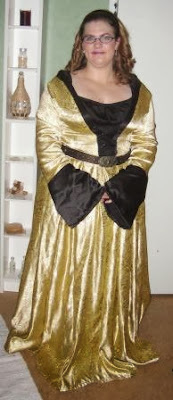 |
| original costume |
Anyway on to the gown. The gown is the second oldest intact female garb in Europe. According to tradition it was worn by Maria of Habsburg at her wedding with Louis II. Today the gown is owned by the Hungarian National Museum, and if go to Budapest some day I really wish to see it. It was restored in the 1980's, but already in 1929 the gown was analyzed and in 1962 an article about the gown with cutting diagrams was published. The best information about the gown, and the cutting diagrams themselves can be found here.
As mentioned, I have loved this gown for a really long time. Some years before 2008 I had bought 6 meters of polyester gold brocade, that I didn't really know how to use. Since I had bought it I had gotten a bit more interested in accuracy, and to me the fabric looked too modern to actually make an historical gown from. In 2009 there was a student ball that in a roundabout way celebrated an event in 1523, so I thought that this was my chance to make something out of the brocade, and to finally make a version of Maria of Habsburg's gown. My aim was not to go for total historical accuracy, but rather something that resembled the general look of the gown.
Since I was going to use the gold brocade I decided that I could be quite free and choose my own colour for the details as well. I ended up using some black poly crepe-backed satin that I had in my stash.
The first layer of the gown is a chemise, made from black interlock that I had at home. I basically used the pattern from the link above, but I didn't do it quite as wide as the original, that would be too bulky due to my fabric not being as lightweight as the original. It was the first time I constructed a chemise, and I found that it was actually quite simple, and that the result is a very comfortable piece of clothing.
For the dress I didn't use the cutting diagram that I found online. I was too unsure that I would be able to enlarge the pattern to something that would fit me. I did have a pattern with a bodice that I knew fitted me quite well, so I once again used my McCall's 4491 pattern. Only this time I cut it off at the waist, and I cut the front wide open. I have no idea what pattern I used for the sleeves, but I possible just took the upper sleeves from the pattern and lengthened them to full sleeves. I was a bit worried that it would stay up, so I added some hidden d-rings at the opening of the front and laced it closed.
 |
| November 2009 |
I'm very happy with the final gown. Too bad I don't have any better pictures of it. It definitely gives a feeling of renaissance opulence, even though it's not in any way accurate when it comes to choice of fabric or techniques that I used to make it.
I would still be happy to wear it, if I found a suitable occasion, but I would change the black poly chemise to one of my more comfortable white linen or cotton chemises.
Status: existing, but non-active.

No comments:
Post a Comment